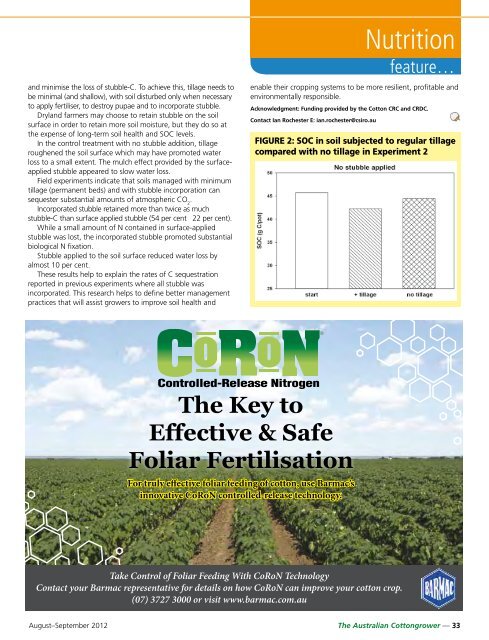growers@sgcotton.com.au Roger Tomkins - Greenmount Press
growers@sgcotton.com.au Roger Tomkins - Greenmount Press
growers@sgcotton.com.au Roger Tomkins - Greenmount Press
You also want an ePaper? Increase the reach of your titles
YUMPU automatically turns print PDFs into web optimized ePapers that Google loves.
and minimise the loss of stubble-C. To achieve this, tillage needs to<br />
be minimal (and shallow), with soil disturbed only when necessary<br />
to apply fertiliser, to destroy pupae and to incorporate stubble.<br />
Dryland farmers may choose to retain stubble on the soil<br />
surface in order to retain more soil moisture, but they do so at<br />
the expense of long-term soil health and SOC levels.<br />
In the control treatment with no stubble addition, tillage<br />
roughened the soil surface which may have promoted water<br />
loss to a small extent. The mulch effect provided by the surfaceapplied<br />
stubble appeared to slow water loss.<br />
Field experiments indicate that soils managed with minimum<br />
tillage (permanent beds) and with stubble incorporation can<br />
sequester substantial amounts of atmospheric CO 2 .<br />
Incorporated stubble retained more than twice as much<br />
stubble-C than surface applied stubble (54 per cent 22 per cent).<br />
While a small amount of N contained in surface-applied<br />
stubble was lost, the incorporated stubble promoted substantial<br />
biological N fixation.<br />
Stubble applied to the soil surface reduced water loss by<br />
almost 10 per cent.<br />
These results help to explain the rates of C sequestration<br />
reported in previous experiments where all stubble was<br />
incorporated. This research helps to define better management<br />
practices that will assist growers to improve soil health and<br />
enable their cropping systems to be more resilient, profitable and<br />
environmentally responsible.<br />
Acknowledgment: Funding provided by the Cotton CRC and CRDC.<br />
Contact Ian Rochester E: ian.rochester@csiro.<strong>au</strong><br />
Nutrition<br />
feature…<br />
FIGuRE 2: SOC in soil subjected to regular tillage<br />
<strong>com</strong>pared with no tillage in Experiment 2<br />
The Key to<br />
Effective & Safe<br />
Foliar Fertilisation<br />
For truly effective foliar feeding of cotton, use Barmac’s<br />
innovative CoRoN controlled-release technology.<br />
Take Control of Foliar Feeding With CoRoN Technology<br />
Contact your Barmac representative for details on how CoRoN can improve your cotton crop.<br />
(07) 3727 3000 or visit www.barmac.<strong>com</strong>.<strong>au</strong><br />
August–September 2012 The Australian Cottongrower — 33

















